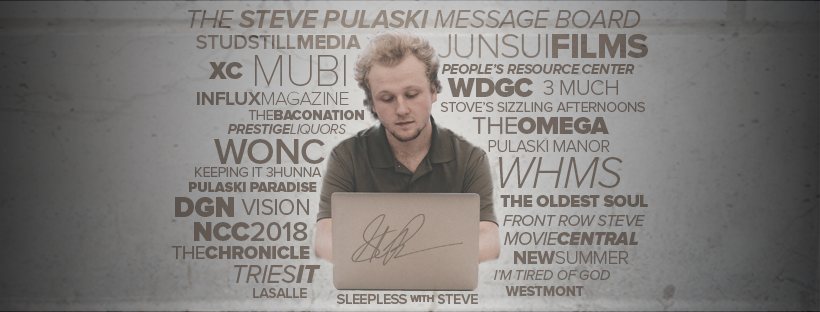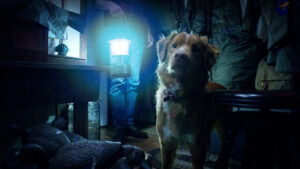Publication Date: 10-06-2025
Good Boy (2025) review
Dir. Ben Leonberg
By: Steve Pulaski
Rating: ★★★
I will open my review of Good Boy the same way I opened my review of A Quiet Place: Day One. I will quell the thought I know is festering in your mind and the worry that might keep you from seeing the film. Yes. It’s true. The dog does indeed live.
The dog — a Novia Scotia Duck Tolling Retriever with gorgeous brown fur and an expressive set of eyes — is also quite possibly the most engaging on-screen canine since the late, great Uggie in The Artist (who nearly netted an Oscar nomination back in 2012). Working with his writing partner Alex Cannon, Leonberg decided that his dog, Indy, would be the perfect star in a horror movie of his own. He committed to the project too, as Good Boy‘s shoot was over 400 days long in order to get the angles, compositions, and behaviors of Indy just right.
That kind of dedication is impressive, as animals in films are typically trained to be performers with jobs to do in the same way service dogs are extensively wired to be able to execute tasks. While I’m often quick to roll my eyes at American cinema’s bedazzling of dogs and marginalizing of cats, I’ll give credit where credit is due to Leonberg for making his good boy the basis of a crafty, mostly solid new horror flick.
Told from the perspective of Indy, the story follows Todd (Shan Jensen), a man, maybe mid-thirties, suffering from what appears to be chronic lung disease. After multiple intensive hospital treatments, and constant nursing from his sister (Arielle Friedman), he grabs Indy and flees to the woods, seeking isolation in the home in which his grandfather lived and died.
An opening montage shows how Todd has raised Indy since he was a puppy, and how he, along with his sister, has been his closest companion for much of his adult life. Since we see the world through Indy’s eyes, we never get a very clear look at Todd’s face, and Indy sure as hell can’t grasp why his human is behaving strangely, vomiting blood and being unusually hostile to him at times. Often, we feel as helpless as the dog, trying to grasp the world around us as apparitions of some kind begin taking shape. Is the Reaper coming for Todd? Is his grandfather haunting him?

Per usual, with these breed of horror, these are questions to which we get limited answers, which is the frustrating aspect of this genre to which Good Boy unfortunately obliges. There’s limited concretization in what is happening, and what Indy sees, and obviously because Indy is a dog, she cannot communicate the paranormalities that she feels closing in on him. At times, Cannon and Leonberg use this murkiness as a screenwriting crutch, relying too much on vibes in place of exposition.
This is underwhelming too because, early on, Cannon and Leonberg’s show a proclivity for minimalist storytelling. We learn of the characters’ names and relationships via Indy’s fleeting eye on his owner’s iPhone. We are tucked into a truck, unaware of where we’re going or why because, after all, Todd isn’t going to expound his motivations in grave detail to a dog. Think about it: if your pet had to tell your story, how much do you think they would know about you, let alone grasp?
Leonberg at least experiments with camera angles and lighting techniques. Serving as his own DP, Leonberg uses a lot of natural, interior lighting in the form of lamps and TV screens in order to illuminate dark rooms. The lighting is deftly positioned so, if nothing else is clear, Indy’s reactions to what she sees (or doesn’t see?) are at the forefront. Being told from a dog’s POV requires a lot of shifty, unconventional angles, and Leonberg and cinematographer Wade Grebnoel clearly fussed over camera placement on many occasions.
If there’s a quality throughline in Good Boy, it’s the feeling of helplessness brought on by seeing a pet at the mercy of his self-destructive, increasingly ailing human. Indy starts to see a long, lanky man covered in mud stalking Todd; a figure reminiscent of a hunter trying to disguise himself in mossy camouflage. Seeing this is about all he can do. He can bark, but that will be quieted by his owner soon enough. He can whimper, but he’ll be the only one to hear it. Leonberg’s story successfully straps us into the seat of a pet, who witnesses more than his human thinks, but is ill-equipped to assist.
Many films involving animals, specifically cats and dogs, manipulate the emotions of American audiences. How could they not? 45% of US households own at least one dog; 32% own at least one cat. Leonberg’s debut might not be perfect, but it accentuates the vulnerability of our closest companions, and even casts a light on their anxieties. In a similar way I’d sometimes rather be in the company of a cat or a dog, I’d rather watch a horror movie pivot and attempt to show a new perspective. I’ve seen many an exorcism and haunting from the view of scared humans.
Starring: Indy, Shane Jensen, Arielle Friedman, and Larry Fessenden. Directed by: Ben Leonberg.
About Steve Pulaski
Steve Pulaski has been reviewing movies since 2009 for a barrage of different outlets. He graduated North Central College in 2018 and currently works as an on-air radio personality. He also hosts a weekly movie podcast called "Sleepless with Steve," dedicated to film and the film industry, on his YouTube channel. In addition to writing, he's a die-hard Chicago Bears fan and has two cats, appropriately named Siskel and Ebert!


